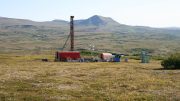Controversial development plans for Northern Dynasty Minerals’ (TSX: NDM; NYSE-AM: NAK) wholly-owned Pebble project in southwest Alaska’s Bristol Bay region, have swung further in the company’s favour following the release of a preliminary version of the U.S. Army Corps of Engineers’ final environmental impact statement (EIS).
The executive summary of the draft EIS, recently leaked to the media, tables a mine development scenario co-existing with the Bristol Bay fisheries that have long cited fish habitat and water resource concerns for the region that a major mine development such as Pebble could potentially trigger. Bristol Bay is home to the world’s largest salmon fishery.
Distributed to federal, state and local co-operating agencies, the U.S. Army Corps of Engineers’ report is still under review by regulatory agencies, including the U.S. Environmental Protection Agency (EPA) and Alaska tribes, although it states “all data gaps” identified during the recent public comment period have been addressed. A final EIS and record of decision for the Pebble project is forecast by mid-2020.
Some of the main points in the draft EIS supporting advancement of the Pebble permitting process include no measurable change in the number of returning salmon, low habitat use in the area of proposed development, impacts to fish and wildlife not expected to impact harvest levels, no effects on any community groundwater or surface water supplies from the changes in groundwater flows at the mine site, and employment and economic benefits for the region.
The Pebble porphyry deposit is one of the world’s largest undeveloped copper and gold projects with 6.5 billion tonnes of measured and indicated resources averaging 0.40% copper, 0.34 gram gold per tonne, 240 parts per million (ppm) molybdenum and 1.2 grams silver per tonne for a contained metal inventory of 57 billion lb. copper, 71 million oz. gold, 3.4 billion lb. molybdenum and 345 million oz. silver. Additional inferred resources of 4.5 billion tonnes grading 0.25% copper, 0.25 gram gold per tonne, 226 ppm molybdenum and 1.2 grams silver per tonne host a further contained metal inventory of 25 billion lb. copper, 36 million oz. gold, 2.2 billion lb. molybdenum and 170 million oz. silver.

Northern Dynasty Minerals’ Pebble copper project in Alaska. Credit: Northern Dynasty Minerals.
The news reinvigorated Northern Dynasty’s optimism in advancing Pebble towards development. In a release following the leaked draft EIS, Tom Collier, the CEO of Northern Dynasty’s wholly-owned Pebble Ltd. Partnership, stated: “We believe the final EIS will support issuing a permit for the construction of a mine at Pebble and that it can be done responsibly. The findings show the project can be developed without harm to the Bristol Bay fishery and would have important economic benefits for communities closest to the mine.”
Investors jumped on the stock following the news, driving up the share price as much as 50% to an almost six-month high of 93¢ on high trading volumes.
In a research note, Cantor Fitzgerald mining analyst Mike Kozak described the event as “another milestone” in the final EIS process. Kozak maintains his ‘speculative buy’ recommendation for the company and has a one-year target price of $1.60 per share.
TD Securities mining analyst Craig Hutchison called the impact of the news “potentially positive” and has a ‘hold’ recommendation on the stock with a one-year target of 75¢.
Following the release of the report, the United Tribes of Bristol Bay (UTBB), long-time opponents to development of the Pebble mine, were quick to counter that the U.S. Army Corps of Engineers’ draft EIS was a rushed process, and alleged that it failed to heed congressional and federal agency directives to do a more thorough analysis of the project’s impact on Bristol Bay.
“Senator Lisa Murkowski authored and passed language in last year’s budget bill demanding the corps do more to address data gaps and agency-identified problems with the EIS,” UTBB Executive Director Alannah Hurley stated in a media release. “This newest version shows a complete disregard for that directive.”
The UTBB is a consortium representing 15 Bristol Bay tribal governments and claims to represent over 80% of the region’s total population.
Northern Dynasty says the U.S. Army Corps of Engineers and co-operating agencies held extensive technical meetings to work through the comments received about the draft EIS.
“The notion that this process has been rushed and that key issues have been ignored is absolutely false,” Pebble Ltd. Partnership’s Collier said. “This process has not been rushed or truncated in any fashion.”
In mid-2019, the EPA removed a 2014 proposed restriction on mining operations in Alaska’s Bristol Bay region clearing the way for the Pebble project to advance through the EIS and permitting process.
If Northern Dynasty can successfully advance its project through EIS and permitting, it likely will be looking to partner with a major mining company to share the significant financial commitment that developing Pebble would incur.
Since initially acquiring an option on the Pebble project in 2001 from Cominco, now Teck Resources (TSX: TECK.B; NYSE: TCK), Northern Dynasty partnered with a few majors over the years looking to evaluate the project only to see them depart. Past shareholders and partners include Rio Tinto (NYSE: RIO; LSE: RIO), Anglo American (LSE: AAL) and First Quantum Minerals (TSX: FM).
At press time, Northern Dynasty was trading at 85¢ giving the company a $371 million market capitalization based on its 437 million common shares issued and outstanding. The company reported a cash equivalent position of $13 million as of Sept. 30, 2019, and subsequently closed equity financings totalling $26 million in December and January.






Be the first to comment on "Leaked EIS buoys Northern Dynasty’s Pebble"